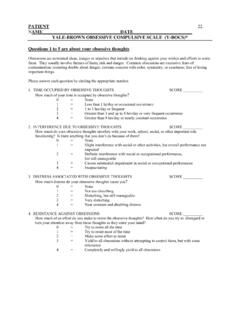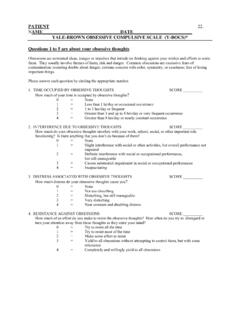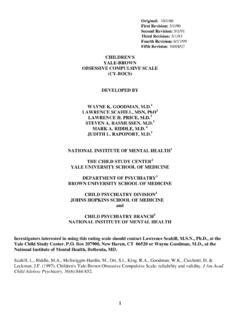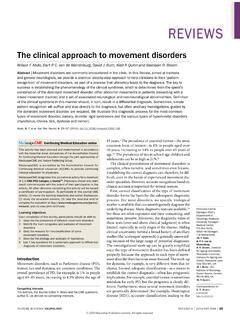Transcription of “JUST RIGHT” OCD SYMPTOMS
1 Just Right OCD SYMPTOMS What is just right OCD? Just right obsessions are thoughts and/or feelings that something is not quite right or that something is incomplete. For example, a Just Right obsession would be a person feeling that their hands are not quite clean when washing them. An example of a Just Right compulsion is a person washing their hands until the sense of incompleteness goes away. On average, those with just right SYMPTOMS experience more problems in their day-to-day lives than those with more typical OCD SYMPTOMS . Those with just right SYMPTOMS are also more likely to have other ( co-morbid ) conditions like tic disorders or skin picking that can make treatment more difficult.
2 How Just Right OCD is Different than More Typical OCD Just right OCD SYMPTOMS involve more of a sense of incompleteness rather than the need to avoid harm seen in more typical OCD SYMPTOMS . Just right SYMPTOMS are more likely to be experienced as discomfort or tension rather than anxiety. How Just Right OCD is Similar to Other Kinds of OCD Both just right and other kinds of OCD involve an overwhelming sense of doubt that leads to compulsions. People with either just right or other kinds of OCD both know that their thoughts are unwarranted, but can not shake the nagging feeling that perhaps they are wrong. In both just right and other kinds of OCD, doing the compulsion reduces anxiety, making the person more likely to seek relief through their compulsion the next time the feeling happens.
3 How can you tell the difference between just right OCD, disruptive behavior and tic disorders ? In children, it may be difficult to tell the difference between just right OCD SYMPTOMS and disruptive/oppositional behaviors. For example, if a child with OCD has a temper tantrum because a classmate sat in her chair, it is because he or she feels an overwhelming sense that something is not right. This reasoning is usually not recognized by others. Limited communication in children can add to the confusion. Because urges in just right OCD and tics feel similar, it can also be difficult to tell them apart. While just right obsessions are less evident than in other OCD subtypes, the urges tend to be more thought-based than tics.
4 In other words, an individual with just right SYMPTOMS may say that something does not feel right and that he/she performs certain rituals to try and get rid of that feeling, whereas a person with tics would tend to show less voluntary control over his/her actions. How are just right SYMPTOMS triggered? A list of possible triggers could be endless. But, the following are some general categories of common triggers: Sight. Example: A person feels that his/her comb is not in quite the right place on the dresser, and might proceed to pick it up and put it back down repeating until the feeling of incompleteness is gone. Sound. Example: A person practicing piano feels that a certain note is off , and needs to play it over and over until it sounds right even though tuning of the note has not changed in any real way.
5 Touch. Example: After touching a table, a person feels a sudden need to touch it again (and again) until a feeling of tension/distress goes away. Personal Expression. Example: A person might need to express himself/herself precisely in written or spoken words (even in his/her own head) working through wording until it meets their own standards of being just right . How much do just right SYMPTOMS interfere with life? How much just right SYMPTOMS impact a person s life can vary from person to person. The following are some common ways that just right OCD can cause problems: Daily Life: Those with very specific triggers might find interference with daily life to be minimal.
6 However, people with more severe just right OCD can become stuck in every step of their day from turning the alarm off in the morning (.. I didn t turn it off right; I need to do it again ) to getting out of bed (.. that felt wrong ..I ll have to do it another time ); walking out the door; picking up objects, etc., etc., etc. Academic/Work Life: Again, those with more severe just right OCD may become stuck in many activities for instance, writing messages (may need to reword or rewrite, if individual letters seem off ); organizing tasks ( , unable to begin, because required objects are not in quite the right place); etc. Productivity can be greatly affected as can attention ( , if the individual is more focused on the sound quality of a speaker s voice, or the rhythm of the words being spoken, than the content of a presentation).
7 Social Life: The compulsions needed for a sense of completeness can take up a lot of time leaving little for social interaction in more severe cases. As well, the oddity of one s compulsions ( , picking up an object and putting it back down, over and over again) may make friendships difficult. Or, as with academic/work life, divided attention can greatly impact performance. What is associated with just right SYMPTOMS ? Over 50% of those with OCD experience just right obsessions or compulsions. Those with just right OCD SYMPTOMS are likely to have: perfectionism ( , concern over mistakes) counting rituals obsessional slowness ( , loss of time due to obsessional loops ) repetitive behaviors a need for control/predictability checking behaviors ordering/arranging/symmetry behaviors/evening-up procrastination ( putting off tasks) a sense that the mind does not rest ( a mental broken record ) trouble delegating tasks greater difficulty making decisions general inflexibility reassurance-seeking ( , comparing notes with others, to determine whether their sense of something being off is valid) Treatment of just right SYMPTOMS .
8 Cognitive-behavioral therapy (CBT), with exposure and response prevention (ERP), is a first-line treatment for OCD. Antidepressant medicines can help, either together with CBT or before starting CBT (to reduce overall levels of anxiety). However, just right SYMPTOMS can make treatment more difficult for two reasons: First, it is often more difficult to address obsessions of incompleteness because they are less concrete than those of harm avoidance. Second, complete response prevention may be difficult for those with severe/very generalized just right SYMPTOMS . More typical OCD SYMPTOMS are triggered by specific things, while just right SYMPTOMS can be affected by virtually every part of the day.
9 Authors: Jeannette Reid, , Eric Storch, , and Adam Lewin, , University of South Florida OCD Program Copyright 2009 International OCD Foundation (IOCDF), PO Box 961029, Boston, MA 02196.















